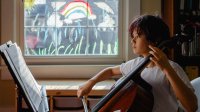How Predictable Routines Can Support Students This Summer
As a difficult school year comes to a close, many students will benefit from planning ahead for summer well-being.
Your content has been saved!
Go to My Saved Content.Our nervous systems thrive on predictable experiences. We predict future experiences based on past ones, but this past year, our educational system has been thrown into chronic unpredictability. For many students, school had been a safe space of connection, and that was stripped from them in March 2020.
In these final weeks of school, teachers can assist students with a smooth transition into the summer and into preparing for the next school year.
Routines, Rituals, and Readiness
Patterned repetitive experiences can help us create new ways of thinking, perceiving, and feeling. Teachers can incorporate a few rituals at the beginning of the day or class period to help students prepare for the day ahead—and the days ahead.
Wall of changes: This wall could be filled with thoughts, poetry, song lyrics, and images that share our celebrations, challenges, strengths, and hopes from this past year and our transition into summer and a new school year. We can post questions to prime students as we bring closure to a tumultuous year of teaching and learning:
- What did you learn about yourself this past year?
- What people or experiences did you miss the most when we were isolated?
- What were the best parts of learning from home?
- What were the hardest experiences?
- Who did you trust this year? What has felt safe to you?
- What has felt unsafe?
- What has been painful?
- What has made you happy?
- What do you hope for this summer?
- If you could choose a book, movie, or song that most resembles your life right now, what would that be?
Summer break box of affirmations: With several weeks of school left, students have time to write affirmations to themselves and to their classmates. Each morning or afternoon, we can ask them to choose a poem, a few words, or a special image, or to create one, and place them in a box until the summer break. During the break, they will have 40 to 50 positive thoughts images or validations they can read each day.
Planning for Summer Well-Being
When the routines and structures of school year end, students sometimes find that summer downtime is boring, depressing, or confusing. This spring, teachers and students can brainstorm together summer planners and activity options, creating calendars of events, ideas for rainy days, or ways to build on personal interests.
Planning with peers and teachers before the summer break allows students to have predictability, choice, resources, and options so they don’t wake up and play video games for five hours straight or sleep their summer days away. To plan, teachers can work with students to research together, exploring summer activities that are fun and safe for all ages.
What are your students’ strengths and interests? We know that our brains learn from patterned repetitive activity, and they are experience-dependent and responsive. Whatever we spend time doing, practicing, or even feeling and thinking gets stronger because the connections in our brains become hardwired with time and practice. Encourage students to use the summer break to delve into their interests, passions, and strengths. Brainstorm with about things they can practice this summer and skills or interests they can work to improve.
- Art: Suggest that students create art for their neighborhood; people who may be lonely or sick might love a colorful image.
- Music: Students can practice with their instrument if they play one, make music with apps like GarageBand or BandLab, teach themselves a new dance, or plan time with friends each week to practice and share their growth and improvement.
- Sports: Encourage students to teach their favorite sport to a group of younger children, or to make videos to share how to improve particular skills.
- Work: Entrepreneurial students may want to create a business this summer—detailing and washing cars, creating logos, or designing a neighborhood service with friends.
- Cooking and food preparation: Encourage students to learn about meals and snacks that are cheap, easy, and fun to prepare.
Focusing on Connection
Research on the pandemic’s effect on mental health is still in the early stages, but current evidence shows a surge in anxiety and depression among children and adolescents. From March to October 2020, the share of mental-health-related emergency department visits rose 24 percent for children ages 5 to 11 and 31 percent for those ages 12 to 17, compared to the same period in 2019.
Creating an emotional first aid kit with students is critical so that they leave school with a plan, connections, and some security in case they experience loneliness or despair over the summer. Here are some points to think about in planning this tool kit:
1. Who are two people you trust that you are able to connect with during the summer break?
2. Are there adults you’ll see over the summer who support you and share in your well-being?
3. Do you have their contact information?
4. Have you established a safe place where you can go if you are fearful, worried, or anxious about anything?
5. Hotlines to call in an emergency: Open Counseling.
If a problem is not too severe, students may benefit from planning for how to calm down when they get upset. Some simple ideas include taking three deep breaths, splashing cold water on their face, texting or calling a trusted friend or family member, taking a walk outdoors, and/or writing a letter or drawing an image of how they feel in the moment.
